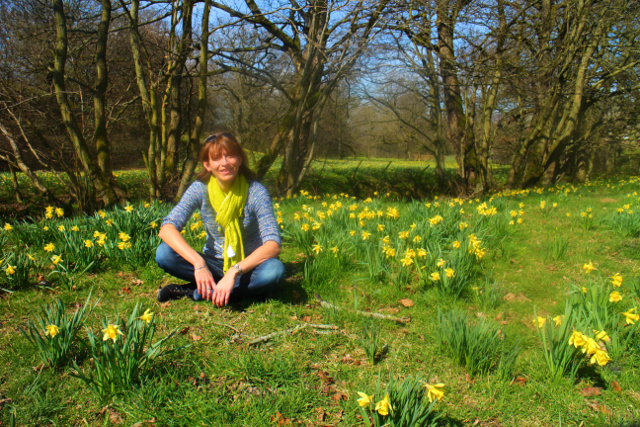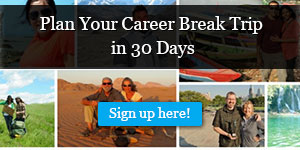Career Breaks: Not a One-Time Thing
Nine months. A lot can happen in nine months. In my case it truly has felt like a rebirth. My time out on my career break from the nine-to-heaven-knows-what-o’clock routine has seen me volunteer, improve my Spanish, travel and write. I not only feel re-energized, but excited by possibilities.
Uncertainty feels a whole lot less scary.

This isn’t the first occasion I’ve left the corporate world temporarily behind.
Back in 2007 my then-partner and I packed our backpacks – he having negotiated a sabbatical from his job, me having left mine – and trundled off on a seven-month around the world adventure.
That break was all about travel and exploring the world.
This time it was all about personal growth.
Both experiences widened my horizons in a way I could only have imagined.
Here I share some of the tips I learned from my first career break, and how I used them to help me plan my second.
Build up your comfort zone
My first career break taught me that my comfort zone is wider than I’d thought. I can live quite happily with just the contents of my backpack. The unfamiliar is exciting, rather than scary. Destinations I hesitated over back in 2006 because I thought they would be a step too far – Laos, Vietnam – I’ve since embraced on two-week vacations.
Stretching your comfort zone can be gradual, but if you never tug on the elastic it won’t ever happen. Albania and Nicaragua helped me expand my comfort zone even further this year. And I loved them both.
Build in some flexibility
If you have several months or more, you don’t have to plan everything to the nth degree. If you’re going to be on the road all that time, do you really want to fix yourself to a flight time nine months away?
On my first career break, all my flights were pre-booked, and my ex and I had also organized our Inca Trail hike (the latter is a wise move, and one I recommend). Whilst this fixed itinerary of flights didn’t leave us with any major problems, we did end up rushing through northern Chile more than we’d have liked to get to our flight from Santiago. And in hindsight we might have organized our time in Australia a little differently.
This time, I kept it simple. My plan was to spend two months in Nicaragua and Colombia, flying out from London via Miami. I booked the return transatlantic flight, and a one-way from Miami to Nicaragua. That was it. As it turned out I couldn’t drag myself away from Nicaragua, so stayed there for the full two months. Colombia has gone on the backburner for another trip.
Having a flexible schedule means you can change plans as you go. I highly recommend it.
Take time to embrace learning

My first career break included a good three months of travel in Latin America. Months in advance I’d bought Michel Thomas’s teach your Spanish CDs and listened to them in my car on my commute to work. On that first trip I didn’t want to “waste” any precious travel time in language school.
Whilst my second career break included a fair dose of travel (one month in SE Europe, two months in Nicaragua); its main focus was on personal growth. Why wouldn’t I use some of that time to improve my Spanish? The two weeks I spent in Spanish language school in Nicaragua is time I don’t regret for a second. Not only did me and the past tense finally get to grips, but I met awesome people and got an insight into Nicaraguan life I would never have otherwise seen. Definitely not time “wasted.”
Budget. And then add a bit
If your career break is focused on travel, you’re going to need money for your accommodation, entertainment, activities, flights, insurance, any ongoing costs at home (eg storage, car insurance), plus some leeway money for when you return, until you get your next paycheck.
On my first career break, there were two things I forgot to money aside for.
The first was souvenirs. Not the $1-$5 dollar variety you might find at markets the world over, but the ones that would be a serious treat. A painting or piece of artwork – of the type you want to bubble wrap home via a reliable air mail service. The kind that might cost a couple of hundred dollars or more.
The second was ad hoc medical expenses and replacement toiletries. Nothing extravagant – sunscreen, contact lens solution, make-up and occasional doctors appointments and prescriptions. $20 here and there soon adds up.
After my second career break, I now own an awesome hammock, and even have a bit of cash left over to buy a stand to hang it from … when the UK weather finally warms up!
Sell it to future employers
In taking a career break, you’ve done something different than a large percentage of the population. That makes you seriously interesting! And interesting makes you stand out from other people up for the same job as you.
You absolutely don’t need to make excuses for having had a career break. It’s a positive decision, so frame it as such. Talk about what you’ve gotten out of it and how those skills can benefit the company.
In seven years, I’ve only ever come across one interviewer who was completely baffled by my choices – even though my CV had 15 years of clear and relevant experience to the role. What that taught me? That I didn’t want to work for him anyway! You’re unique, and you deserve better than “one size fits all” attitudes.
If you love it, make it part of your life

A year ago, a friend advised me to write myself a little essay. It’s a “week in the life of Julie”, set 12 months in the future.
The narrative I wrote myself, based on my post career-break life, illustrated in a startling two-page missive of how important flexibility was to me in my work life. I used this second career break to give those options for flexibility a good kick-start.
I started my own travel blog and now earn my living through a mixture of short-term contracting in marketing/communications roles and freelance writing work – both blog and non-blog related.
My tip is this: if something is important to you, look at how you can design your life to give you the chance to make it happen.
For me, I’ve trying to design my work life to give me flexibility and the future option for travel. Not necessarily for the long-term, but more than a typical four-week vacation allowance would normally provide. Colombia, I’m comin’ at ya!
Need help planning your career break trip? Check out the following articles and resources:
- Sign up for our free e-course – Plan Your Career Break Trip in 30 Days
- How to Set a Travel Budget and Stick to It
- 8 Tips for Preparing to Leave on a Career Break
- To Plan or Not to Plan Your Career Break – 5 Factors
Julie Sykes is a proud Yorkshire gal, travel-aholic and occasional art lover. She loves nothing more than getting (mildly) lost in a strange city. Julie is founder of The Gap Year Edit, which offers tips and ideas about alternative holidays and grown up gap years. Julie’s mission is to hear you say, ‘I’m so glad I did it!’ instead of, “I wish I could, BUT …”







